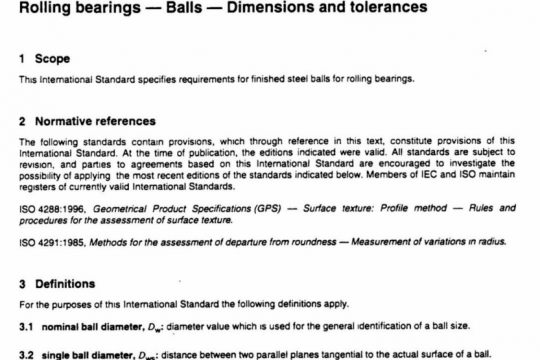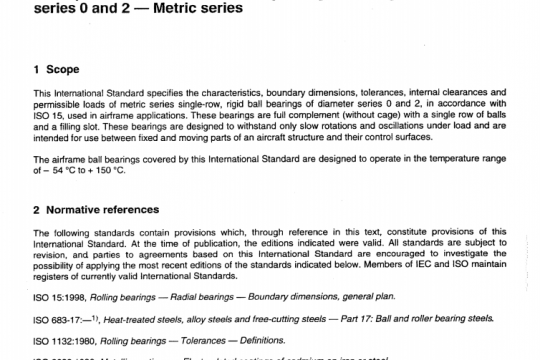ABMA 14:1995(R2008) pdf free
ABMA 14:1995(R2008) pdf free.AMERICAN NATIONAL STANDARD ABMA STANDARD
This standard specifies boundary dimensions and tolerances for ball bearings with spherical outside surfaces and extended inner ring width. The feature of mating housing and bearing spherical surfaces is intended to provide initial self-alignment at mounting. Included are pillow block, flanged and take-up unit housings.
The housings in this standard are commonly made from ferrous materials. Those shown in tables 1, 2, 3 and 4 are generally cast, whereas those shown in tables 5, 6 and 7 are generally pressed.
Relubrication features are optional and may be designed to interface with the lubrication holes of mating bearings covered by ANSIABMA Standard 15, Ball Bearings with Spherical Outside Surfaces and Extended Inner Ring Width (Includes Eccentric Locking Collars), so that bearings may be properly relubricated.This standard does not include the design or dimensions of relubrication features.
Note 1 – The symbols (except those for tolerances) shown in the figures and given in the tables denote nominal dimensions unless
otherwise specified.
A width of base
D. spherical seating diameter of housing,nominal
H distance from mounting base to centerline of spherical seating diameter
Hλ distance from mounting base to centerline of spherical seating diameter of alternate design housing
H height of feet
J center distance between bolt holes,nominal
L length of base
N width of bolt hole
N; length of bolt hole
A width (attachment end)
A1 width of location slot
A2 width over location slot flanges
D. spherical seating diameter of housing,nominal
H height (overall)
H distance between bottoms of location slots ;
H2 height (attachment end)
L length (overall)
L distance from attachment end face to centerline of spherical seating diameter
L2 length (attachment end)
Ls length of bottom slot
N diameter of attachment hole
N; length of attachment slot
N2 height of attachment slot.
Tables 1, 2, 3, 4, 5, 6 and 7 represent commonly used housing types. The boundary dimensions in these tables are selected to reduce variations and maximize standardization yet provide sufficient number of configurations to satisfy present and future need of users.ABMA 14 pdf free download.




